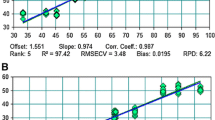Abstract
The F1 and F2 progenies of eight-parent diallel crosses were used to investigate the mode of inheritance of fatty acids, oil, and protein in safflower (Carthamus tinctorius L.) seeds. The results indicated significant differences among the parents for general (GCA) and specific combining ability (SCA). Relatively high narrow-sense heritability was estimated for fatty acids including linoleic (0.84), oleic (0.77), palmitic (0.61), and stearic (0.6) acids. The high narrow-sense heritability and the high ratio of GCA/SCA mean squares for all the fatty acids investigated indicate the important role of additive gene action in controlling these traits. In our experiment, however, low narrow-sense heritability was obtained for oil (0.37) and protein (0.28) contents. Furthermore, the estimates of genetic variance components proposed the importance of non-additive genetic effects that contribute to variation in oil and protein content. The overall results indicated that K21 × Mex.22-191 cross could be employed for the production of high oil yielding and high oleic acid safflower lines in breeding programs.
Similar content being viewed by others
References
Singh RJ (2007) Genetic resources, chromosome engineering and crop improvement. CRC Press Inc, Florida
Dajue L, Mundel HH (1996) Safflower (Carthamus tinctorius L.). IPGRI, Italy
Weiss EA (2000) Oil seed crops, 2nd edn. Blackwell Science, Oxford
Fernandez-Martinez JM, Rio M, Haro M (1993) Survey of safflower (Carthamus tinctorius L.) germplasm for variants in fatty acid composition and other seed characters. Euphytica 69:115–122
Cosge B, Gurbuz B, Kiralan M (2007) Oil content and fatty acid composition of some safflower (Carthamus tinctorius L.) varieties sown in spring and winter. Int J Nat Eng Sci 1:11–15
Camas N, Cirak C, Esendal E (2007) Seed yield, oil content and fatty acid composition of safflower (Carthamus tinctorius L.) grown in northern Turkey conditions. J Fac Agric, OMU 22:98–104
Bergman JW, Flynn CR, Kott RW, Hatfield PG, Van Wagoner H, Boles JA (2001) Feedlot performance, carcass composition and muscle and fat conjugated linoleic acid concentrations of lambs fed diets supplemented with high linoleic safflower. In: Bergman JW, Mündel HH (eds). Proceedings of the fifth international safflower conference, Williston, ND, Sidney, MO, USA
Delourme R, Falentin C, Huteau V, Clouet V, Horvais R, Gandon B, Specel S, Hanneton L, Dheu JE, Deschamps M, Margale E, Vincourt Pand P, Renard M (2006) Genetic control of oil content in oilseed rape (Brassica napus L.). Theor Appl Genet 113:1331–1345
Wang X, Liu G, Yang Q, Hua W, Liu J, Wang H (2010) Genetic analysis on oil content in rapeseed (Brassica napus L.). Euphytica 173:17–24
Hamdan YAS, Perez-Vich B, Velasco L, Fernandez-Martinez JM (2009) Inheritance of high oleic acid content in safflower. Euphytica 168:61–62
Echer R, Yaniv Z (1993) Genetic control of fatty acid composition in seed oil of Sinapis alba L. Euphytica 69:45–49
Joshi SK, Sharma SN, Singhania DL, Sain RS (2004) Combining ability in the F1 and F2 generations of diallel cross in hexaploid wheat (Triticum aestivum L. em. Thell). Hereditas 141:115–121
Mercer LC, Wynne JC, Young CT (1990) Inheritance of fatty acid content in peanut oil. Peanut Sci 17:17–21
Okoh JO, Ojo AA, Vange T (2007) Combining ability and heterosis of oil content in six accessions of castor at Makurdi. Nat Sci 5:18–23
Bachlava E, Dewey RE, Burton JW, Cardinal AJ (2009) Mapping and comparison of the quantitative trait loci for oleic acid seed content in two segregating soybean populations. Crop Sci 49:433–442
Griffing B (1956) Concept of general and specific combining ability in relation to diallel crossing systems. Aust J Biol Sci 9:463–493
Jinks JL, Hayman BI (1953) The analysis of diallel crosses. Maize Genet Coop News 27:48–54
Mather K, Jinks JL (1982) Biometrical genetics. Chapman and Hall, London
SAS Institute, Inc (1999) SAS/STAT user’s guide. SAS Institute, Inc, Cary.NC
Zhang Y, Kang MS (1997) DIALLEL-SAS: A SAS program for Griffing’s diallel analyses. Agron J 89:176–182
Ukai Y (1989) A microcomputer program DIALL for diallel analysis of quantitative characters. Jpn J Breed 39:107–109
Banerjee PP, Kole PC (2009) Analysis of genetic architecture for some physiological characters in sesame (Sesamum indicum L.). Euphytica 168:11–22
Vares D, Lacombe S, Griveau Y, Berville A, Kaan F (2002) Inheritance of oleic acid content of F1 seed in a complete diallel cross between seven sunflower lines. Hellia 36:105–112
Turi NA, Farhatullah F, Khan NU, Munir I, Shah AH, Khan S (2010) Combining ability analysis in Brassica juncea L. for oil quality traits. Afr J Biotech 9:3998–4002
Ramachandram M, Goud JV (1981) Genetic analysis of seed yield, oil content and their components in safflower (Carthamus tinctorius L.). Theor Appl Genet 60:191–195
Mosjidis JA, Yermanos DM (1984) Maternal effects and cytoplasmic inheritance of oleic and linoleic acid contents in sesame. Euphytica 33:427–432
Erickson EA, Wilcox JR, Cavins JF (1988) Fatty acid composition of the oil in reciprocal cross among soybean mutants. Crop Sci 49:433–442
Ashokkumar K, Ravikesavan R (2008) Genetic studies of combining ability estimates for seed oil, seed protein and fibre quality traits in upland cotton (G. hirsutum L.). Res J Agric Biol Sci 4:798–802
Singh S, Singh VV, Choudhary AD (2010) Combining ability estimates for oil content, yield components and fibre quality traits in cotton (G. hirsutum) using an 8 × 8 diallel mating design. Trop Subtrop Agroecosys 12:161–166
Acknowledgments
This work was partially funded by Center of Excellence for Oilseed Crops at Isfahan University of Technology, Isfahan, Iran.
Author information
Authors and Affiliations
Corresponding author
About this article
Cite this article
Golkar, P., Arzani, A. & Rezaei, A.M. Genetic Analysis of Oil Content and Fatty Acid Composition in Safflower (Carthamus tinctorius L.). J Am Oil Chem Soc 88, 975–982 (2011). https://doi.org/10.1007/s11746-011-1758-3
Received:
Revised:
Accepted:
Published:
Issue Date:
DOI: https://doi.org/10.1007/s11746-011-1758-3




